Emotion modeling or electronic sense of novelty
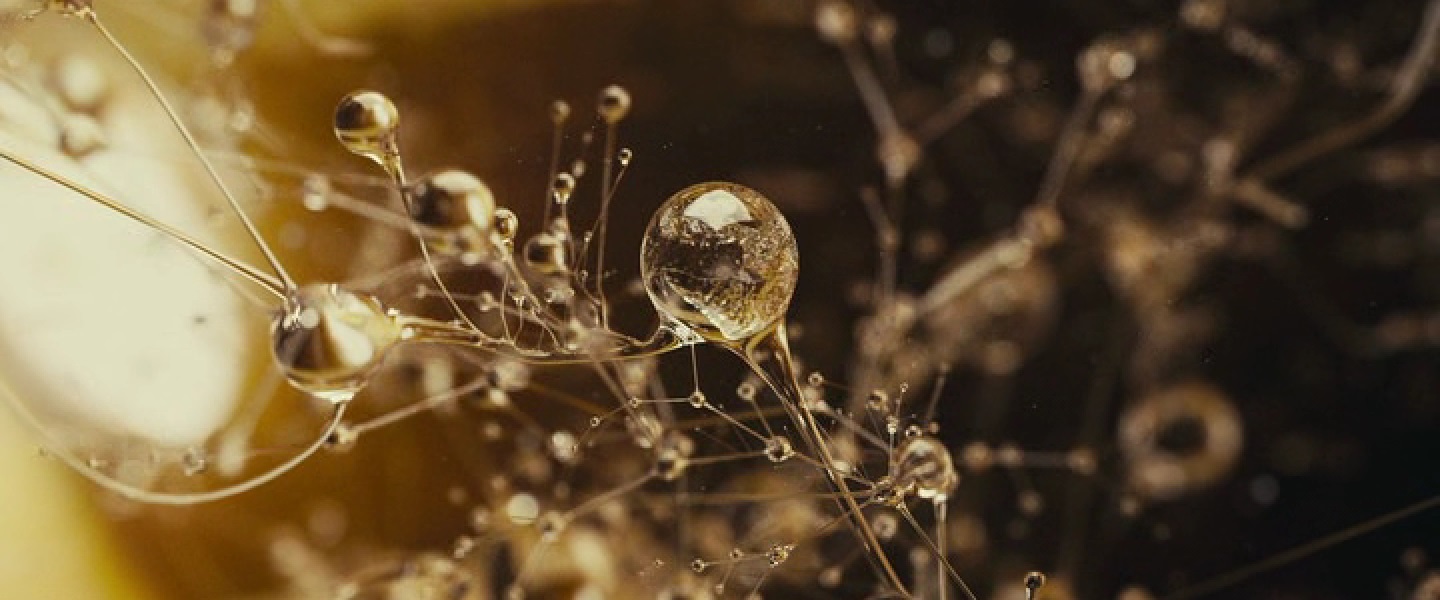
Without an understanding of the nature of the emergence of intelligence and the mechanisms of rational behavior, the creation of artificial intelligence is impossible. One can infinitely compose neural-like networks by varying their number, organization, algorithms, but it is impossible to repeat in a random way what evolution has been working on for millions of years.
The nature of the activity of living organisms is determined by their needs associated with the need to survive, feed, multiply and save energy. And not a single living being acts outside the inner motives that are shaped by needs. And it is impossible to imagine a mind devoid of internal motives and goals. Each movement of our eyes, the pronouncing of words, the formation of thoughts is the result of the work of the mechanisms responsible for meeting our needs. The desire to create absolute intelligence, not due to any needs, will result in an inactive mechanism or acting like an automaton.
Our world is very complex and diverse and the creation of reflexes for all occasions that would allow the body to be successful in this world is not possible. Therefore, nature has created a mechanism that allows the formation and selection of reflexes that lead to the desired result - these are emotions, or emotional mechanisms.
But what kind of needs artificial intelligence can have, because there is no need for him to experience hunger, a person can follow the charge of his battery, and fear can provoke actions to self-defense, love and affection - these feelings even created many troubles for Man. The only thing that artificial intelligence really needs is a desire to learn, curiosity and a desire for the new. The nature of all emotions is similar and all of these emotions, perhaps, to embody in artificial intelligence.
There are many different areas and divisions in our brain, and it can be said that there are certain interconnections, these connections are, as it were, of a higher level than those that are present between neurons. These departments influence each other through chemical signals; this is a slower type of information channel. For example, we have already talked about what changes occur to the cortex under the action of noradrenaline, the neurons of the cortex become more plastic, noradrenaline occurs in the cortex due to the activation of the blue spot. When we discussed the modulating neuroelement, I gave an example with a feeling of fear that can increase the sensitivity of motor neurons, thereby making us stronger and faster. Each emotion is due to its area in the brain, or a group of areas, the causes of occurrence, as well as actions,
For most emotions, two states can be distinguished: hunger and satiety. Thirst and quenching thirst, prolonged muscle tension and relaxation, fear and a sense of avoiding danger, pain and pain retreat, boredom and emotion of novelty, the absence of an object of affection and the joy of contact with an object of affection - all these are two parts of emotional mechanisms.
What is hunger?

Imagine a certain region of neurons in the nervous system, in which with increasing need the activity will increase, the higher the need, the more often there will be an activation of these cells and the more they will be involved in the activity. And accordingly, in the absence of the need for activity in these cells will not. You can call these cells - the cells of demand, as if they require the performance of actions necessary for their calming down.
Try to hold your breath and you will feel the effect of the cells of the requirement of the respiratory center. Over time with the holding of breath, the signals from the internal organs about the increase in carbon dioxide will come to the nerve center responsible for breathing, increasing its activity in it. Activity increases to such an extent that it will soon be impossible to hold back breath through the inhibiting effect of the cortex. And this nerve center with its activity will cause the necessary reflex to inhale. Each need has its own requirements neurons, although in some cases the work of groups of these cells is interrelated.
A living organism can have many needs and there are priorities between these needs, the need for self-defense is always higher than the need to satisfy food hunger. And nature has placed these priorities by means of the maximum level of activity for the corresponding cells of the demand and mutual suppression. The body will perform those reflexes that are associated with the satisfaction of the cells of the requirements that currently dominate in his nervous system.
Gordon №324 Egoism and Altruism of the Neuron
Обратите внимание, что активность растёт и достигает пика до совершения действия, после происходит полное потухание. Фиксируется не совсем та активность которую я описываю, но даст некоторое представление о принципах работы системы. Если бы, электрод был помещен в центр пищевого голода и насыщения, то фиксировал бы источник этих активаций.
Эфир 02.12.2003 — но сохраняет актуальность.
Обратите внимание, что активность растёт и достигает пика до совершения действия, после происходит полное потухание. Фиксируется не совсем та активность которую я описываю, но даст некоторое представление о принципах работы системы. Если бы, электрод был помещен в центр пищевого голода и насыщения, то фиксировал бы источник этих активаций.
Эфир 02.12.2003 — но сохраняет актуальность.
Consider how the needs and emotions control the behavior of the animal, and what internal processes occur in this process.

To do this, we will consider a specifically configured system in the program. The system has two areas A and B, these areas are necessary so that we can logically separate and isolate the groups of neuroelements. Area A is the area responsible for some need, and Area B has a set of simple reflexes. Three reflexes with headers Q, W, E (a) whose activation leads to three actions “1”, “2”, “3”, respectively (b), each reflex has representations in the area A В, and the transfer of excitation between the reflex and the representation has a bilateral nature. Such an organization is derived from the principles of the organization of the nervous system, but it is greatly simplified. Areas responsible for emotions and needs are localized in the limbic system; these areas are closely related to the hippocampus,
Through the stimulus A, we can activate the need (d), this stimulus can symbolize, for example, a signal from the internal organs about the absence of the necessary nutrients, which leads to the feeling of hunger and the activation of the corresponding cells of the requirement (e). There may also be a number of additional stimuli that have only a modulating effect on the cells of the requirement, for example, the delicious smells of food can increase the sensitivity of the cells to the requirements of food hunger, which will increase their activity. But in the absolute absence of hunger, the smell of food will not affect the behavior of the animal.
Suppose that when performing the action "2" animals, this will lead to the satisfaction of needs and obtaining saturation (f). The neuroelement (g) will be responsible for saturation, the activity of which leads to imprinting in area A. In this case, the area changes neuroplasticity by one second from 0 to 0.1 and back (h), as well as removal of actions of habituation processes. for neuroelements. When we discussed the topic of memory, we talked about the mechanism of emotional memory and this is an example of how this mechanism is used. The center of the requirement (i) responsible for the activity of the cells is also suppressed, but this does not happen instantly, but with some delay, so that there is a possibility of associative links. An analogue of these processes is the activation of dopamine neurons, The dopamine mediator is inhibitory, it has an inhibitory effect in the areas responsible for hunger. It is also possible to release various “hormones of happiness”, which affect the plasticity of certain areas in the brain, change the ability to concentrate attention and perception, reduce pain threshold, etc., which together can be interpreted as states of euphoria, or an increase in mood.
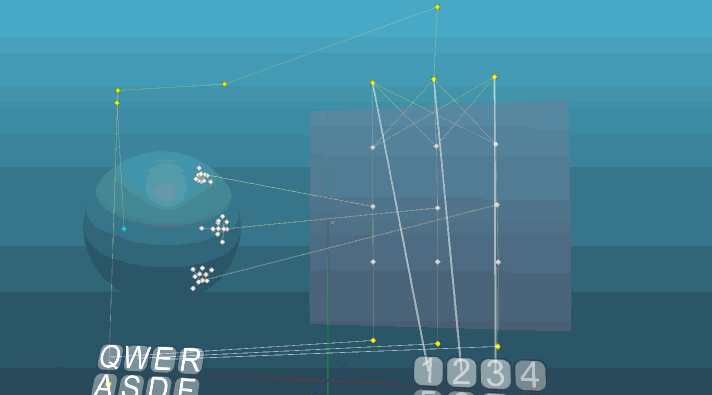
Even with the activity of a neuroelement, the requirement to perform actions that do not lead to saturation do not cause any significant changes in area A. But when you first start the reflex leading to saturation, a reflex arc is formed connecting the neuroelement requirements and representing the reflex leading to the necessary actions. Thereby, a closed loop is formed: the emergence of demand leads to the activation of the neuroelement of the requirement, which activates the reflex, which forms the actions leading to the activation of the saturation center. The feeling of saturation suppresses activity in the neuroelement of the requirement, before the need arises again. With each repetition, the formed reflex arc will be strengthened by increasing the strength of the synapses. In this case, the maximum synapse force is set to 100, with plasticity 0,
If we further cancel the condition: by action “2” lead to saturation, then if a need arises, this action will be persistently carried out, at first very active, but over time the habituation processes will lead to the attenuation of the implementation of this reflex, and the adaptation processes will contribute to periodic return to action "2". There are no mechanisms for erasing the information, and the reflex arc will remain. The reflex arc can be lost due to the retraining and participation of neuroelements belonging to it in other reflex acts. In a biological system, a situation is possible when useless actions will be suppressed by the needs related to the conservation of energy, and according to the same scheme, only the need will always arise when performing any actions and saturation when performing reflexes suppressing the action of motor neurons, as a result of inaction. Only we will think about the implementation of the action "2" how the thought arises: "It is not worth trying is useless." And it is better when the needs related to energy conservation would be lower in priority and strength of other needs.
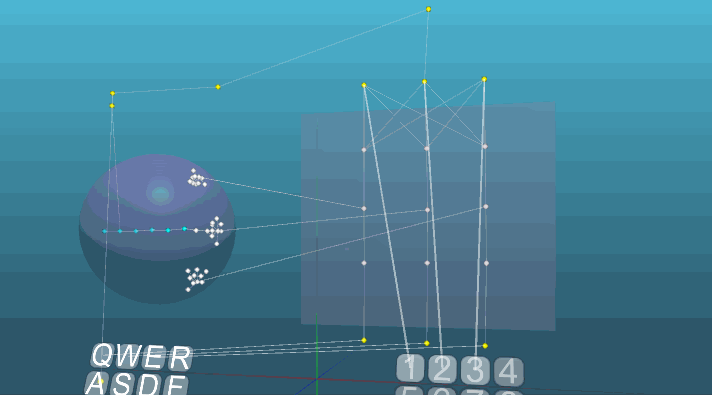
Another option is to add a condition that the action “1” will lead to saturation. In this case, it is not enough just to introduce a new condition, it is necessary to demonstrate to the body at the very beginning that there is such an opportunity, that is, to train it. After several acts of learning, when a need arises, both actions are possible, although these actions may compete when they are performed simultaneously. More often, the reflex act will be performed, the reflex arc of which is more stable, in which there are stronger connections, in the end this reflex will fully dominate. Simply put, the body is easier to perform those actions that previously led to positive results, of course, if this does not affect other needs.
If, for example, performing action “1” is more efficient for saving energy, then it will give him an advantage over action “2”.
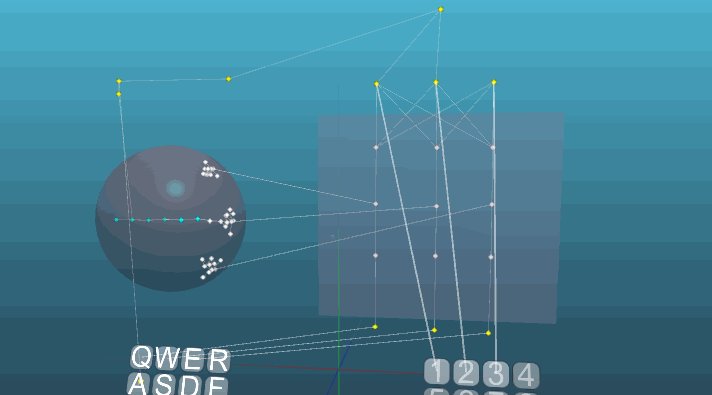
And of course, complete retraining is possible, even with the most stable reflex, if one establishes the appearance of feeling of saturation only in response to the action “1”. This will also require some training. After which some time it is possible to perform action “2” (“out of habit”), but ultimately the body will perform only action “1” when a need arises.

The considered mechanism of work of emotions and satisfaction of needs is effective only if there are certain reflexes of actions prepared in advance and by the teacher, which, when necessary, will lead to the execution of the necessary actions. In fact, this is quite consistent with living nature, but what about the situation when the body tries to independently study the environment. This is possible thanks to the need for novelty that is very important for learning the need for new information.
As for any other need, the emotional mechanism of the need for novelty works according to similar principles, and accordingly we need to highlight a certain criterion of the novelty of the incoming information. If for some long time the organism does not receive new information, then the need should arise and the requirements corresponding to it should be activated.
The need for obtaining new information appears evolutionarily relatively early, and physiologists find in the nervous system some basic neural networks to assess the novelty of information. For example, a neural network that allows you to register abrupt changes in the level of sound, such networks are necessary to attract the attention of the organism to the changing aspects of the environment.
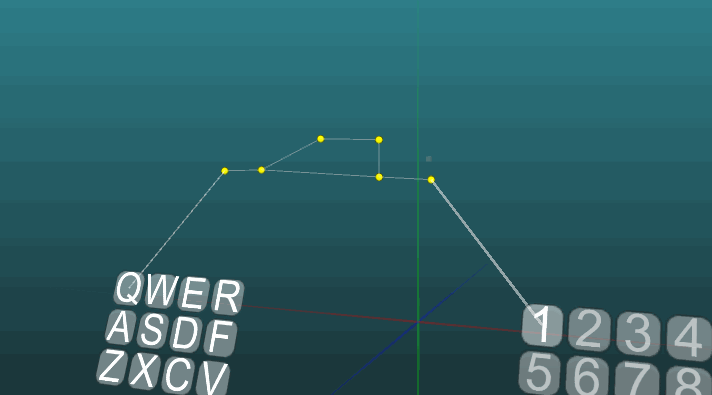

But it is difficult to imagine a scheme that can evaluate the newness of information at the level of abstract thinking, at the level of formation of images and associations. For an associative neuroelement, there is a very simple way to evaluate new information on the change in the vector of preferred excitation propagation. The angle between the old value of the vector direction and the new one calculated at the time of activation may differ from 0º to 180º, the greater this angle, the more significant the change of external factors influencing the vector count. Having this criterion of novelty for each neuroelement at the moment of its activation, you can get a medium-term value of the level of novelty.
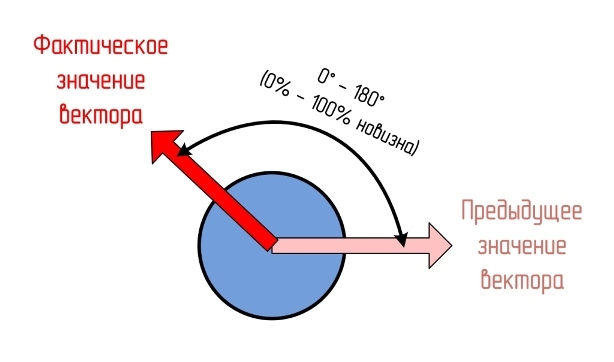
In a biological analogue, there may be a certain chemical signal, that a neuron has to launch a program to change the strength of its synapses under the influence of external factors.
In order to understand what is the emotion of novelty, I want to present a quote from the book by Bauer T. "Mental development of the infant":
The baby can turn on the light by turning its head to the left. Most 2-3 month old babies turn on the light several times in a fairly short amount of time. Then the frequency of turns to the left falls below the level that serves as a criterion for learning. It will not increase as long as there is a stable connection between the ignition of the light and turning the head to the left. Suppose that the experimenter changes the direction of the connection: the light comes on when the head turns to the right. Sooner or later, the baby will turn its head to the left and the light will not turn on. In this case, there is a large number of turns to the left, then the detection of the right scheme, as indicated by a short high frequency of turns to the right, which then decreases. If the situation does not change, this frequency will also remain low.
If the reinforcement pattern changes again, so now to turn on the light, you first need to turn your head to the left and then turn to the right, then the frequency of the right turns will increase after the first attempt, when the light does not turn on; the frequency of the left turns also increase, and finally the baby will turn its head to the left, then to the right and turn on the light. After a brief increase in the frequency of turns to the left — to the right, the frequency will decrease and will be constant until the situation changes. The change of the reinforcement program causes an outbreak of activity, which ceases after finding the right combination of turns. Thus, the child develops rather complex sequences of movements: for example, to the right - to the right - to the left - to the left. An increase in activity is observed every time the situation changes. Studies show that this activity is not accidental. The baby sort of goes through a series of hypotheses, testing the sequence of movements to find out which of them is effective at the moment. Finding the right one, he checks it several times and then stops the pronounced activity. It increases again only in the case when the previous sequence ceases to be applicable. It is quite clear from the behavior of babies that the light stimulus is not a motivating factor.
When hypothesis testing begins, the baby after the first success almost does not look at the light source. He gives him a glimpse of him to see if he has turned on or not. Making sure that the light comes on, he can show signs of pleasure, but he does not pay attention to the light source, which is clearly not the reason for its satisfaction.
Let us analyze the internal mechanisms of the child’s behavior from the example described using the model example:

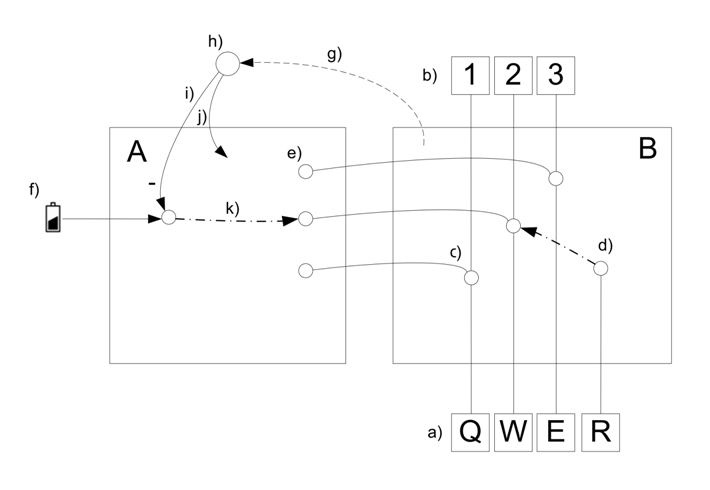
Two areas A and B, the first is the area responsible for the emotion of novelty, the second area is the area in which the assessment of the level of novelty of the received information takes place. Area B has four input signals (a). Suppose that signal Q is some kind of internal or external motive of turning the head to the left, this motivating signal activates the corresponding reflex leading to action “1” (b), which will be the act of turning the head left. A similar stimulus W, but to turn the head to the right. The stimulus E can be an internal motive of turning the head first to the left, then to the right, in the area of the primotor cortex images of whole combinations of movements are formed, therefore the presence of this reflex representation is quite logical. And the stimulus R is the result of the appearance of a visual image of the inclusion of light. Reflexes,
Combinations of stimuli will form new reflex arcs, new ways of propagation of excitation, which will indicate a high level of novelty of information, and the repetition of the same combinations will each time show an ever lower level of novelty.
In this example, a more sophisticated novelty assessment algorithm is used, which allows one and the same combination to be assessed by the level of novelty with a drop of 10-20% on each repetition, but based on the difference in the change in the vector of preferred excitation propagation. The value of the level of novelty on the gif'ka can be seen on the right above the area B.
In the absence of information with a novelty level above 70% in area B, information starvation occurs within 10 s, a need arises for novelty (f). The emotion of novelty in relation to other needs is very low, but the need for its satisfaction arises very quickly, i.e. the need for novelty is inferior in cases of the need for self-preservation, the emotions of fear are always stronger, but the need for novelty is almost insatiable. For example, this emotion governs the saccades of our eyes; at the time of viewing the images, as soon as the information transmitted from the eye receptors has a low level of novelty, the eyes move. The extent to which the eye moves in the image quickly, indicates the speed of hunger-saturation cycles for the emotion of novelty. Of course, the level of novelty for different areas of the brain can be assessed differently.
A high level of novelty (> 70%) in area B leads to the activation of a neural network (h), which for a short period of time increases the plasticity in area A and removes the habituation effect in it (j) in order to form reflex arcs that will be associated with actions that led to saturation. Next is the suppression of the activity of the cell requirements (i).
Actions that lead to saturation of the need for newness will be repeated, even if they do not bring satisfaction, but in this case it is possible to suppress the action by the influence of other needs, for example, the need for energy conservation, or the emergence of addiction. Combinations: turning the head and turning on the light or turning the head and not turning on the light will be evaluated equally by the level of novelty when changing them.
At each saturation, there will be a decrease in the effect of habituation in the area responsible for the emotion of novelty, which will lead to the emergence of activity of previously learned reflexes. In the process of learning old reflexes will be embossed with new ones.
In the nervous system there are areas responsible for individual muscle contractions - the motor, or motor cortex, but also areas in which whole combinations of these movements are formed - the primotor cortex. It is possible that the presence of a region with a higher abstract level, in which a certain image is formed: “turns by the head,” the connection with this image of the center of need for novelty, can lead to an imitation of the search for combinations of turning on the light.
Children often ask questions like: “Why?” Only because the center of their emotions of newness is connected with the commission of this action, their experience prompts them that by asking this question, there is a chance of receiving new information and, accordingly, satisfying the need of newness.
The need for novelty is very important for learning how to master the articulation apparatus and motor skills. These systems have feedback, actions of motility, motor activity are immediately reflected in the receptors of the organs of vision, touch, vestibular apparatus, and the action of the articulatory apparatus affects the receptors of the organ of hearing. In the early stages of animal development, the combination of action and perception of the results of this action forms new reflex arcs, which, taking into account the emotional mechanism of the need for novelty, leads to the desire to repeat these actions, as well as combinations of similar actions.
An example would be baby talk, which actively begins at about the age of six months baby. This stage of development of the child is started through the activation of unconditioned reflexes provoking the pronunciation of sounds, but is supported by the emotions of novelty, forcing the child to pronounce the same sounds or play them.
The pursuit of active games, interaction with objects, etc. allows the animal and man not only to satisfy the need for novelty, but also teaches how to control their body and shape its image.
Mechanisms to meet the needs are universal enough to highlight the internal criteria of hunger and saturation. For example, consider the emotion of affection. There are different types of attachment: mutual attachment of mother and child, attachment to a spouse, relative, etc. This emotion is expressed in the desire to be close to the object of affection or to have it in sight. In case of loss of the object of attachment, an anxious or stressful state can arise, and if the object of attachment returns, joy and other signs of pleasure are manifested. The research and experiments of the Australian ethologist Conrad Lorenz demonstrate the mechanisms of attachment emotion. For example, examining the behavior of ducklings, Lorenz found that the baby hatched from an egg first searches for the "image of the mother."
The only thing that a candidate for the role of mother had to do was move. If a moving object appears before just hatched ducklings, the ducklings begin to follow him. The process of recording an attachment image in memory is called imprinting. After one day, after the birth, the imprint of the mother of the ducklings ends. After that, they completely ignore even their real mother. And more willingly follow the "surrogate mother."
At certain key moments of the vital activity of the organism, labeling of cells of active images occurs and presumably this occurs with the help of the mediator oxytocin. Oxytocin is called the hormone of trust and affection, it is released during successful social contacts and interactions, when breastfeeding, mutual grooming and having sex. The nervous system remembers those neurons that are active at the time of increasing oxytocin levels.
The criterion of hunger for attachment emotion can be a low level of activity of “tagged” neurons, and the saturation criterion is the activity of these neurons. According to the described scheme of satisfaction of needs, the nervous system will be memorized, and those actions that lead to a state of saturation of need will be performed. The desire to admire the face of the beloved, crying of the child and grasping at parting with the mother, manifestation of maternal tenderness and care, grief over the loss of kinship or loss of a pet - all are the result of the work of brain centers responsible for attachment emotions.
The presented model of the emotional mechanism allows us to talk about the qualitative characteristics of individual emotions. By changing the rate or measure of saturation, the rate of onset of hunger, the total maximum level of activity of the cell requirements in relation to other emotional centers, it is possible to shape the character of the modeled nervous system.
The level of curiosity, the strength of attachments, courage, greed, sense of duty, laziness, cheerfulness, these and many other qualities of character are due to the initial settings of the centers that meet needs.
Software developers with artificial intelligence will face not only technical tasks, but also tasks related to the mental qualities of the program, this is well illustrated in the film “Eve: Artificial Intelligence” (2011).
Understanding the nature of emotions will help to “program” artificial intelligence to fulfill the three laws of robotics; these will not just be some instructions, but the implementation of these laws will bring real joy and happiness to the artificial mind.
Table of Contents
1. The nervous system simulator. Part 1. Simple adder
2. Nervous system simulator. Part 2. Modulated neuroelement
3. Nervous system simulator. Part 3. Associative Neuroelement
4. Memory, memory consolidation and grandmother's neurons
5. Emotion modeling or electronic sense of novelty
6. Amazing cerebellum
7. Brain structure and initial settings
